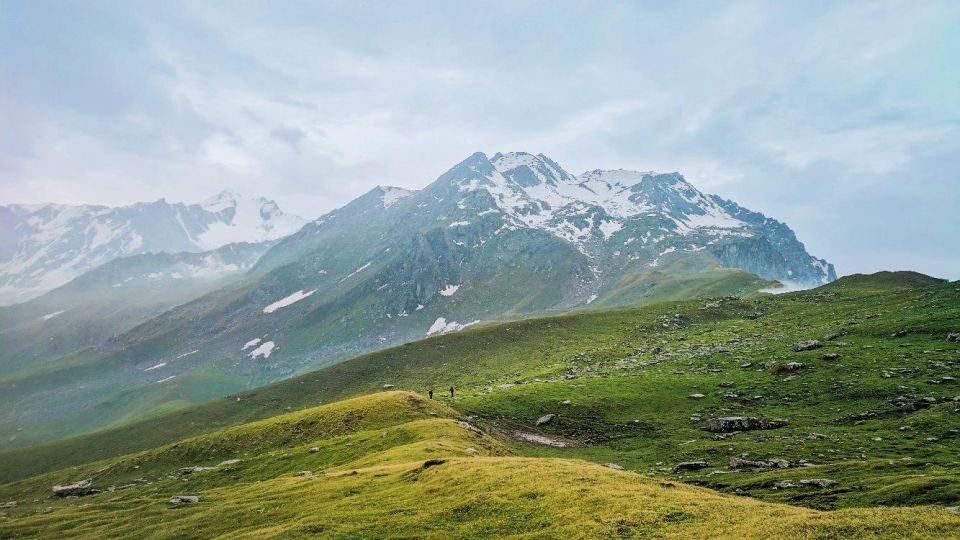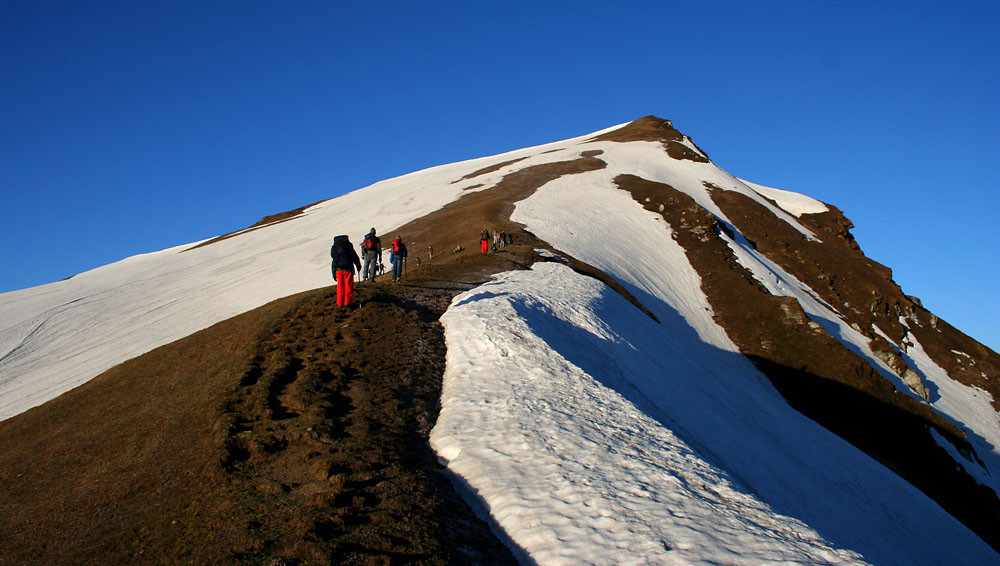Enquiry
Your Review
Short Itinerary
| Day | Source to Destination (km) | Trek or Travel Duration (hours) |
|---|---|---|
| Day 1 | Kasol to Grahan Village - 10 km |
Trek Time : 4-5 hours |
| Day 2 | Grahan to Min Thach - 7 km |
Trek Time : 4-5 hours |
| Day 3 | Min Thach to Nagaru - 8 km |
Trek Time : 5-6 hours |
| Day 4 | Nagaru - Sar Pass - Biskeri Thach - 14 km |
Trek Time : 7-8 hours |
| Day 5 | Biskeri Thach to Barshaini - 10 km , Drive back to Kasol - 15 km |
Trek Time : 4-5 hours Scenic Drive : 1 hr |
Overview
The Sar Pass Trek is an exhilarating 6-day adventure through the enchanting Parvati Valley in Himachal Pradesh, covering approximately 50 kilometers. Starting in the quaint village of Kasol, known for its serene ambiance and vibrant culture, the trek takes you through dense pine forests and along the Grahan Nallah stream to the picturesque Grahan Village. From there, the trail ascends through mixed forests of oak and rhododendron to the expansive meadows of Min Thach, offering panoramic views of surrounding mountains. The steep and challenging path to Nagaru provides spectacular vistas of the Pir Panjal and Dhauladhar ranges. The most thrilling part of the journey is crossing the Sar Pass at 13,800 feet, with its snow-covered terrain and awe-inspiring views of the peaks and valleys. The descent to Biskeri Thach takes you through pristine alpine meadows and forests, with the campsite offering lush green fields and a panoramic view of the Himalayas. The final leg of the trek descends to Barshaini, passing through dense forests, small streams, and charming villages, before a short drive back to Kasol. The Sar Pass Trek is a perfect blend of lush greenery, snow-clad mountains, and serene alpine meadows, providing a diverse and unforgettable Himalayan adventure.
Trek from Kasol to Grahan Village
Grahan Village to Min Thach
Min Thach to Nagaru
Nagaru to Biskeri Thach via Sar Pass
Biskeri Thach to Barshaini, Drive to Kasol
- Distance: 10 km trek, 15 km drive
- Trek Duration: 4-5 hours
- Scenery: The final day of the trek involves a descent to Barshaini, passing through dense forests, small streams, and charming villages. The trail offers stunning views of the Parvati Valley. From Barshaini, a short drive takes you back to Kasol, where the trek concludes.
The Sar Pass Trek is a journey through diverse landscapes, offering a perfect blend of thrill and tranquility, making it an unforgettable Himalayan adventure.
Please note that trekking times are approximate and may vary based on individual and group fitness levels. The itinerary is subject to weather conditions and other unforeseen circumstances.
Policies
Ensuring Safety, Compliance, and Conservation
At Trekvento, we prioritize the safety of our trekkers, uphold environmental conservation, and ensure compliance with trekking regulations. Our policies are designed to provide a safe and enjoyable trekking experience while preserving the natural beauty of the Himalayas.
Trekkers Safety Measures
Qualified Guides: Every trek is led by experienced and certified trek leaders who prioritize safety and have extensive knowledge of the trekking routes.
Emergency Protocols: Detailed emergency protocols are in place, including first aid training for staff and evacuation procedures in case of emergencies.
Equipment Inspection: Regular inspection and maintenance of trekking gear and equipment to ensure reliability and safety during the trek.
Altitude Acclimatization: Trek itineraries are carefully crafted to allow for gradual altitude acclimatization, minimizing the risk of altitude sickness.
Weather Monitoring: Continuous monitoring of weather conditions to anticipate and mitigate potential risks.
Trek Regulations and Compliance:
Permits and Permissions: Adherence to all necessary permits and permissions required for trekking in protected areas, ensuring legal compliance and environmental conservation.
Leave No Trace Principles: Implementation of Leave No Trace principles to minimize environmental impact, including proper waste disposal and responsible camping practices.
Respect for Local Culture: Respectful interaction with local communities, adherence to cultural norms, and support for local economies through responsible tourism practices.
Group Size Limits: Maintain manageable group sizes to minimize ecological impact and ensure personalized attention and safety for all trekkers.
Wildlife Conservation: Respect wildlife habitats and observe wildlife from a distance, without disturbing their natural behavior or environment.
Trek Rules and Guidelines:
Mandatory Briefing: All trekkers are required to attend a pre-trek briefing covering safety protocols, environmental ethics, and trekking guidelines.
Stay on Designated Trails: Trekkers must stay on designated trails to minimize soil erosion and habitat disturbance, ensuring the preservation of delicate ecosystems.
No Smoking and Alcohol: Smoking and consumption of alcohol are strictly prohibited during the trek time to maintain a healthy and safe environment for all participants.
Follow Guide Instructions: Trekkers must follow the instructions of the trek leaders and guides at all times, especially during emergency situations or challenging terrain.
Conclusion: At Trekvento, we are committed to providing a safe, sustainable, and memorable trekking experience for all our participants. By adhering to our trek policy, trekkers can enjoy the beauty of the Himalayas while contributing to environmental conservation and respecting local communities.
FAQs
What things each trekker should carry ?
Footwear:
Waterproof trekking boots, comfortable sneakers, and flip-flops.
Woolen socks for warmth.
Backpack:
Main backpack (50 liters), daypack (20-30 liters), and a duffel bag.
Clothing:
Waterproof jacket and trousers, fleece jacket, thermal innerwear, t-shirts, trekking pants, and shorts.
Additional warm layers like sweaters and down jackets.
Hats, gloves, and scarves for hand and head protection.
Accessories:
Sunglasses, water bottle, hydration bladder, headlamp, and spare batteries.
Trekking Gear:
Emergency toolkit, sunscreen, toiletry kit, water purification tablets, Ziploc bags, earplugs, and first-aid kit.
Additional Items:
Towel, raincoat or poncho, lip balm, and sunscreen lotion.
Trekking pole or walking stick for stability.
Medications and personal toiletries.
Rain cover for your backpack and a small daypack for essentials during the day.
Poly bags or plastic containers for organizing items during heavy weather.
What happens if I cancel the trek?
Trek Cancellation by TrekVento:
If a trek is canceled due to natural disasters or unforeseeable circumstances, you'll receive a full trek voucher valid for one year.
Your Cancellation:
Canceling 30 or more days before the trek: Full refund.
Canceling between 30 and 15 days before the trek: 60% refund.
Canceling less than 15 days before the trek: No refund.
Refunds are subject to a 4% deduction as cancellation charges.
Trek insurance refunds are not provided.
Responsibility:
TrekVento is not liable for any damage or injury to your belongings during the trek.
The trek fee covers all trek expenses from start to finish.

